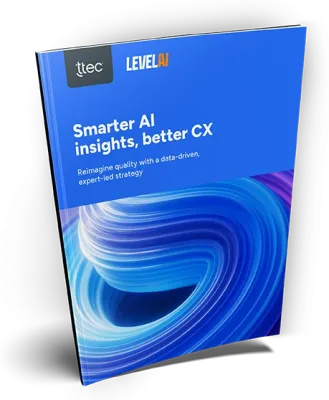The key ingredient to any successful business initiative is the people who make it possible. Having employees perform at their best sets companies up to win. This is especially true in customer-facing interactions. Your front-line employees represent your brand to customers, and their performance can make or break relationships, as well as keep operations running smoothly.
Front-line employees follow a similar path of hiring, training and development. And just as it’s important to focus on key initiatives throughout a customer lifecycle, the same holds true for employees. Throughout this lifecycle, data-driven insights can fuel employee performance, satisfaction, and retention. And having happy, knowledgeable, invested employees more easily translates into increased customer satisfaction. Both historical and predictive insight can enhance a company’s ability to create productive, engaged workers.
For example, in the recruitment phase, talent acquisition leaders can determine the most predictive pre-hire characteristics of future employees, based on common attributes of their most successful associates, such as education and high levels of empathy. In the training and development phases, employee or trainer stats can be analyzed to find positive and negative outliers in performance during training and in live environments. The curriculum can be modified based on performance and on how effective the methods are in both training and the live environment. And retention analysis can help companies focus on the rewards or recognition associates enjoy most (bonuses, days off, longer breaks, control over schedule); who is likely to attrite and when; and where there are training gaps based on comparisons between training and live performance.
This goes well beyond performance management. Many companies track historical training program performance data to gauge success of a training initiative from the associate and trainer perspective. But added value comes when the data creates actionable insight in near real-time that answersthe question, “What can I do better?”
Our approach mixes performance data in the training environment with structured and unstructured data from other business units to determine the likelihood of success along the entire end-to-end employee lifecycle. It combines historical and ongoing analysis to get a full picture of performance, operations, and the customer experience.
Data from the HR department such as candidate education and experience, job fit, and personality profiles add more context to hiring practices, as well as how different types of associates succeed with different types of training, for example. And customer experience data, including CSAT, NPS, voice-of-the-customer data, and sales figures, also help tell the larger story. System and operational metrics also give context with insight about the entire contact center’s volume or utilization during the measurement period. Leveraging data from across the enterprise at each stage of the employee lifecycle ensures a complete picture on which to draw insights and recommendations.
Within the employee lifecycle, particular attention should be paid to the training phase. It is where a bulk of investment is already taking place. A dynamic training curriculum can connect directly with live associate performance, and two-way insight can improve operations and training on the fly and over the long term, improving ROI. The following example shows how a health insurance company monitored and managed its training program with a dynamic use of insight-driven EX to optimize current operations and predict future employee performance.
Performance data turns to valuable insight for health insurer
We recently worked with a leading health insurance company to enhance the effectiveness of its contact center employee training program. The company wanted to monitor key success metrics during training and post-training to provide timely guidance and data-driven insights aimed at increasing associate success. Its associates often work with complex healthcare issues, so a mix of knowledge and soft skills is essential to the success in the role. Training focused on the mechanics of serving members, empathy, and other soft skills.
We tapped into a variety of data systems used in its training environment—learning management system (LMS), telephony, quality, trainee surveys, and adherence—to track daily individual and cumulative performance, as well as operational progress. The data was used to uncover attributes that correlate with future success, as well. And the analysis continued to track performance and identify areas of need once associates began live member interactions. By extending our analysis into the live environment, we uncovered valuable insights that otherwise would have stayed hidden.
For example, we discovered that some of the simulated scenarios were much more challenging in the training environment than in real life. Actual customers were much calmer than in the simulations. More time than needed was taken up in training to deal with these unrealistic scenarios. In addition, some trainees lost confidence during these modules, which impacted their overall performance. The team modified and simplified the curriculum to more nearly match what they would experience when interacting with live customers. Instead of focusing on how to handle difficult customers, trainers now focus on how to advise, consult, and build empathy during interactions.
To share these insights, we created customized dashboards of the most relevant KPIs for employee and trainer success. Three dashboards were generated—daily dashboards for trainers to track the progress of each of their classes, weekly dashboards for training managers to assess the overall training program, and monthly dashboards for senior executives that highlight big picture trends. This insight was previously unavailable to the executive leadership who run the business. The dashboards provide regular, automated feedback to stakeholders that can be acted on in near real time (see Figure 1). They put more information in the hands of the people who can make impactful changes.
Answer the golden retention question
The health insurance example only scratches the surface of how to leverage insights across the employee lifecycle. For example, attrition is a critical pain point within the contact center industry. Predictive modeling can identify the key drivers of associate attrition and performance within a specific business that can be acted on. Attrition drivers include an increase in tardiness or absences, lack of experience, challenging shifts, or low quality scores. Performance drivers include employment tenure, training class participation and engagement, and pre-hire survey responses. When combined, the data create insight about the specific employees who are most or least likely to exhibit each behavior.
When margins are tight, as they are in today’s competitive business landscape, the ability to gather insights about employees early on related to their future performance is a critical asset. It helps companies decide who to invest in, what to focus on, and how to mold them into high performers. This next generation of insight-driven EX arms companies with information they need to make decisions that affect the employee lifecycle today and tomorrow.















